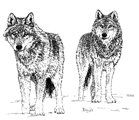Wildlife Damage Management, Internet Center for
Date of this Version
March 2002
Abstract
Wolves (Canis lupus) in the Northern Rocky Mountain states (Idaho, Montana and Wyoming) continue to increase in distribution and numbers (Figures 1, 5). Estimates of wolf numbers at the end of 2002 were 284 wolves in the Central Idaho Recovery Area, 271 in the Greater Yellowstone Recovery Area, and 108 in the Northwest Montana Recovery Area for a total of 663 (Figure 1, Table 4a). By state boundaries, there were an estimated 263 wolves in the state of Idaho, 217 in Wyoming and 183 in Montana (Table 4b). Of approximately 80 groups of two or more wolves, 43 met the definition of “breeding pair,” an adult male and female raising two or more pups until December 31. This made 2002 the third year in which 30 or more breeding pairs were documented within the three-state area. Recovery criteria have been met for removing these wolves from the Endangered Species List (Table 4a). It is expected that the process of delisting could begin in 2003 if state management plans are in place. Wolves in the area subsist mainly on elk (Cervus elaphus), white-tailed deer (Odocoileus virginianus), mule deer (Odocoileus hemionus), moose (Alces alces), and bison (Bison bison). Livestock depredations in 2002 included 52 cattle (Bos taurus), 99 sheep (Ovis aries), nine dogs (Canis familiaris) and five llamas (Lama glama) confirmed lost to wolves (Table 5a, 5b). Approximately 23 of 80 known wolf packs were involved in livestock depredations. In response, 46 wolves were killed within the 3-state area. No wolves were translocated in 2002. As new packs are formed between the original core recovery/release areas, the three populations increasingly resemble and function as a single, large population (Figure 1). Approximately 12 research projects are underway, examining wolf population dynamics, predator-prey interactions and livestock depredation.


Comments
This cooperative annual report presents information on the status, distribution and management of the recovering Rocky Mountain wolf population from January 1, 2002 through December 31, 2002. It is also available at http://mountain-prairie.fws.gov/wolf/annualrpt02/ U.S. Fish and Wildlife Service, Nez Perce Tribe, National Park Service, and USDA Wildlife Services. 2003. Rocky Mountain Wolf Recovery 2002 Annual Report. T. Meier, ed. USFWS, Ecological Services, 100 N Park, Suite 320, Helena MT. 64 pp.